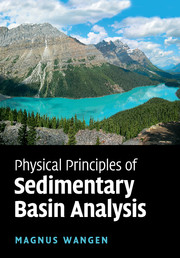Book contents
- Frontmatter
- Contents
- Preface
- Acknowledgments
- 1 Preliminaries
- 2 Properties of porous media
- 3 Linear elasticity and continuum mechanics
- 4 Compressibility of rocks and sediments
- 5 Burial histories
- 6 Heat flow
- 7 Subsidence
- 8 Rheology: fracture and flow
- 9 Flexure of the lithosphere
- 10 Gravity and gravity anomalies
- 11 Quartz cementation of sandstones
- 12 Overpressure and compaction: exact solutions
- 13 Fluid flow: basic equations
- 14 Fluid flow: basic equations
- 15 Wells
- Appendix: Fourier series, the discrete Fourier transform and the fast Fourier transform
- References
- Index
12 - Overpressure and compaction: exact solutions
Published online by Cambridge University Press: 07 May 2010
- Frontmatter
- Contents
- Preface
- Acknowledgments
- 1 Preliminaries
- 2 Properties of porous media
- 3 Linear elasticity and continuum mechanics
- 4 Compressibility of rocks and sediments
- 5 Burial histories
- 6 Heat flow
- 7 Subsidence
- 8 Rheology: fracture and flow
- 9 Flexure of the lithosphere
- 10 Gravity and gravity anomalies
- 11 Quartz cementation of sandstones
- 12 Overpressure and compaction: exact solutions
- 13 Fluid flow: basic equations
- 14 Fluid flow: basic equations
- 15 Wells
- Appendix: Fourier series, the discrete Fourier transform and the fast Fourier transform
- References
- Index
Summary
This chapter looks at overpressure build-up caused by porosity reduction during deposition and burial of sediments. Sediments compact when they get buried, either mechanically from the increasing weight above, or by chemical processes. Mechanical compaction takes place in the upper part of a basin, which is too cold for chemical (diagenetic) reactions to be sufficiently effective. The porosity reduction and compaction happens by chemical process further down in the sedimentary basin, where mechanical compaction is arrested by mineral cement. The rates of the chemical processes increase rapidly with increasing temperature. Porosity reduction implies expulsion of fluids from the pore space, and a pressure gradient is needed (in Darcy's law) to drive the expulsion. Fluid expulsion therefore leads to overpressure build-up during deposition and compaction. This chapter shows the basic behavior of overpressure build-up with simple analytical models. One common simplification of these models is that they consider deposition of just one lithology at a constant deposition rate.
Thanks to the oil industry a large number of wells have been drilled in offshore areas where deposition is currently taking place. The mud weight used to balance the formation pressure in wells is a valuable indication of the overpressure, although it is not a precise pressure measurement. It is normally larger than the formation pressure in order to ensure that there is no outflow from the formations. Figure 12.1a shows the mud density of an overpressured well offshore mid-Norway and Figure 12.1b shows where the corresponding fluid pressure is between the hydrostatic water pressure and the lithostatic pressure.
- Type
- Chapter
- Information
- Physical Principles of Sedimentary Basin Analysis , pp. 385 - 416Publisher: Cambridge University PressPrint publication year: 2010



